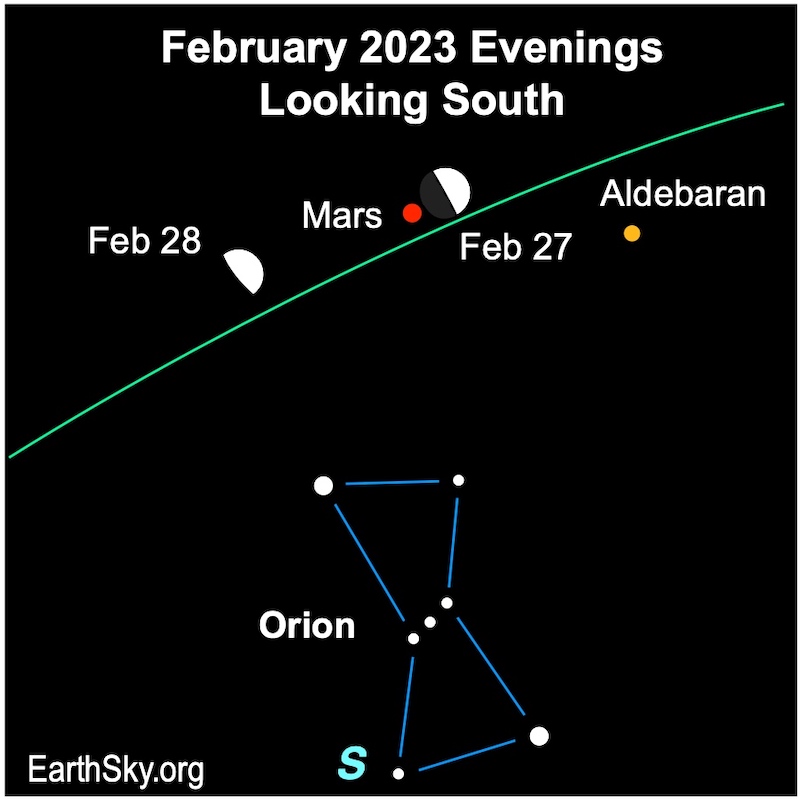
Our charts are mostly set for the northern half of Earth. In order to see a precise view from your location, try Stellarium Online.
See the moon near Mars
The moon will be passing by Mars on the nights of February 27 and 28, 2023. And the first quarter moon occurs on the evening of February 27, 2023. Then, it’s a waxing gibbous moon the following night.
Mars has a roughly two-year cycle of visibility in our sky. And, for much of that cycle, it’s faint and inconspicuous. But – for a period of about six months, every couple of years – Mars brightens and appears quite red. It happens around the time Earth is passing between Mars and the sun. And that’s what happened in December 2022.
We passed between the sun and Mars on December 8, 2022, when Mars reached opposition. So, we’re racing away from Mars now, in our smaller, faster orbit. As a matter of fact, right now Mars appears as big and bright as it will for the rest of the year. That’s because Mars has faded from its recent opposition at magnitude -1.9 to its current magnitude +0.4. While that is still brighter than most stars, Mars is now fading day by day.
Last chance to get a moon phase calendar! Only a few left. On sale now.
The stars near the moon and Mars
The reddish star near Mars is Aldebaran, the Eye of Taurus the Bull. Aldebaran can guide you to a V-shaped star cluster known as the Hyades. Also, the delicate star cluster of the Pleiades shimmers nearby.
Following the moon and Mars across the sky is the mighty constellation Orion the Hunter. Notice the reddish color of Betelgeuse? How does its color compare to Aldebaran and Mars?
Bottom line: Watch for the moon near Mars from dusk until around midnight local time on the nights of February 27 and 28, 2023.
The post Moon near Mars February 27 and 28 first appeared on EarthSky.
from EarthSky https://ift.tt/Pg8GtWm

Our charts are mostly set for the northern half of Earth. In order to see a precise view from your location, try Stellarium Online.
See the moon near Mars
The moon will be passing by Mars on the nights of February 27 and 28, 2023. And the first quarter moon occurs on the evening of February 27, 2023. Then, it’s a waxing gibbous moon the following night.
Mars has a roughly two-year cycle of visibility in our sky. And, for much of that cycle, it’s faint and inconspicuous. But – for a period of about six months, every couple of years – Mars brightens and appears quite red. It happens around the time Earth is passing between Mars and the sun. And that’s what happened in December 2022.
We passed between the sun and Mars on December 8, 2022, when Mars reached opposition. So, we’re racing away from Mars now, in our smaller, faster orbit. As a matter of fact, right now Mars appears as big and bright as it will for the rest of the year. That’s because Mars has faded from its recent opposition at magnitude -1.9 to its current magnitude +0.4. While that is still brighter than most stars, Mars is now fading day by day.
Last chance to get a moon phase calendar! Only a few left. On sale now.
The stars near the moon and Mars
The reddish star near Mars is Aldebaran, the Eye of Taurus the Bull. Aldebaran can guide you to a V-shaped star cluster known as the Hyades. Also, the delicate star cluster of the Pleiades shimmers nearby.
Following the moon and Mars across the sky is the mighty constellation Orion the Hunter. Notice the reddish color of Betelgeuse? How does its color compare to Aldebaran and Mars?
Bottom line: Watch for the moon near Mars from dusk until around midnight local time on the nights of February 27 and 28, 2023.
The post Moon near Mars February 27 and 28 first appeared on EarthSky.
from EarthSky https://ift.tt/Pg8GtWm

Aucun commentaire:
Enregistrer un commentaire